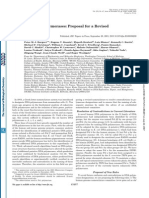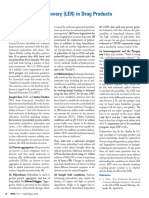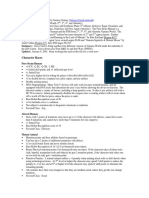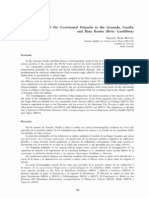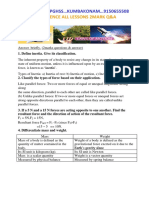d41586-024-00080-1
d41586-024-00080-1
Uploaded by
HaiCopyright:
Available Formats
d41586-024-00080-1
d41586-024-00080-1
Uploaded by
HaiCopyright
Available Formats
Share this document
Did you find this document useful?
Is this content inappropriate?
Copyright:
Available Formats
d41586-024-00080-1
d41586-024-00080-1
Uploaded by
HaiCopyright:
Available Formats
families as new metagenomes were added to present and how abundant they are (the taxo- Duisburg-Essen, Essen,
isburg-Essen, Essen, 45141, Germany.
their analysis. Instead, the detection of protein nomic composition), and examining genes that e-mail: alexander.probst@uni-due.de
families increased exponentially, warranting are associated with certain functions. Finding
an array of follow-on studies. specific but differentially abundant protein
The distribution of protein families across families of unknown function, as demonstrated 1. Rodríguez del Río, A. et al. Nature 626, 377–384 (2024).
Earth’s categories of ecosystem (biomes) by Rodríguez del Río and co-workers, has the 2. Vanni, C. et al. eLife 11, e67667 (2022).
3. Pavlopoulos, G. A. et al. Nature 622, 594–602 (2023).
presented by Pavlopoulos and colleagues potential not only to replace current marker- 4. Jumper, J. et al. Nature 596, 583–589 (2021).
corroborates the findings of previous investi- gene-based approaches for differentiating 5. Doron, S. et al. Science 359, eaar4120 (2018).
gations regarding the distribution of microbial microbiomes but also to advance microbiome 6. Illergård, K., Ardell, D. H. & Elofsson, A. Proteins 77,
499–508 (2009).
genes8. Some biological entities, however, research to a new and causality-driven level. 7. Tyson, G. W. et al. Nature 428, 37–43 (2004).
were particularly rich sources of newly dis- 8. Coelho, L. P. et al. Nature 601, 252–256 (2022).
covered protein families, including viruses, as Alexander J. Probst is in the Research Center 9. Eme, L. et al. Nature 618, 992–999 (2023).
Pavlopoulos et al. report, and microbes called One Health Ruhr, University Alliance Ruhr, The authors declare no competing interests.
Asgardarchaeota, as presented by Rodríguez Department of Chemistry at University of This article was published online on 30 January 2024.
del Río and colleagues. The latter are a group
of microorganisms called archaea that are
Cancer
closely related to the first ancestor of eukar-
Natural inhibitor found for
yotes. As such, studying their proteins might
reveal new insights into the evolution of the
eukaryotic cell9.
One major challenge in exploring the
wealth of previously unknown protein fami- cell death by ferroptosis
lies encoded in genomes of natural samples
is the identification of eukaryotic genes in
Donna D. Zhang
metagenomes. Although certain algorithms
exist for the recovery of eukaryotic genomes The discovery that an evolutionarily conserved molecule used
from metagenomes, accurately predicting to make cholesterol also acts as a defence against a cell-death
eukaryotic genes in mixed DNA sequences
— equivalent to Pavlopoulos and colleagues’
mechanism called ferroptosis might lead to new ways to treat
method of identifying microbial genes — is still cancer and other clinical conditions. See p.401 & p.411
not possible bioinformatically. Once this short-
coming is overcome with the development of
new algorithms, scientists will substantially Biology remains nothing short of astonish- of ferroptosis. However, one of the enzymes,
expand the protein ‘sequence space’ and will ing, as researchers unveil the underpinnings DHCR7, which catalyses the reaction that
identify protein families of unknown func- of its myriad systems, especially those that are converts 7-DHC to cholesterol, was found
tion that drive the ecology and evolution of involved in protecting against cell death. On to promote ferroptosis. This indicates that
eukaryotes. pages 401 and 411, respectively, Freitas et al.1 7-DHC, produced by the enzyme SC5D and
The greatest advance in painstakingly and Li et al.2 shed light on a regulated form of used by DHCR7, operates as a key protection
organizing the protein families of nearly cell death called ferroptosis, which is driven against ferroptosis.
27,000 metagenomes and across the tree of life by an iron-dependent modification of lipids Both teams then explored the mechanism
lies in the identification of ecosystem-specific in cellular membranes. The results bring into of action of 7-DHC in more detail. They high-
protein clusters that differ in terms of their sharp focus an unexpected hero, the molecule lighted a key characteristic of its structure — a
presence or absence, or relative abundance 7-dehydrocholesterol (7-DHC). part that is described as a conjugated double
between varying conditions of a given eco- The term ferroptosis was coined in 2012 bond in the sterol B-ring. This component
system — for example, between the contexts (ref. 3). This cell death encompasses a variety of its structure enables 7-DHC to absorb
of health or disease. Applying this strategy to of processes that include lipid oxidation by the radicals, thereby reducing lipid fragmenta-
examine microbial data for healthy people action of reactive molecules called radicals tion driven by an oxidation process called
and those with colorectal cancer, Rodríguez (versions of molecules that have an unpaired peroxidation.
del Río and colleagues found that specific electron) and the fragmentation of lipids at cel- Both teams recognized that it is mainly lipid
unknown protein families were enriched in lular membranes, culminating in membrane components called phospholipids — espe-
the gut bacteria of people with cancer. These disruption, shrunken mitochondrial organelles cially if these are fragmented into smaller
protein families were associated with micro- and swelling of cells (‘ballooning’). Ferroptosis pieces — that can initiate ferroptosis. These
bial motility, adhesion and invasion poten- occurs when there are problems in the regula- findings underscore the protective function
tially of human tissue, as revealed through tion of normal iron levels (iron homeostasis) of 7-DHC, especially in scenarios in which
genomic-context analysis. Harnessing this and in the oxidation of lipids. Preventing ferrop- ferroptosis might otherwise occur if this
approach in other fields of research should tosis might be beneficial in alleviating neurode- molecule wasn’t present.
be extremely helpful for deciphering the dif- generative and kidney diseases, and activation Most remarkably, the two teams also found
ferent functions of sample sets, in the hope of ferroptosis can kill cancer cells4–7. that the molecule ergosterol, which is found
of identifying new targets for biochemical Freitas et al. and Li et al. report that 7-DHC, a in yeast and fungi and has structural similar-
analyses to shed light on a tiny fraction of the molecule in the cholesterol-synthesis pathway ity to 7-DHC, also offers protection against
microbial dark matter. (Fig. 1), acts to suppress ferroptosis. Both teams ferroptosis. This finding suggests that the
Identifying differences in microbial com- independently discovered the anti-ferroptotic anti-ferroptotic effect of a molecule in the
munities (microbiomes) that might explain, role of the cholesterol-synthesis pathway. The cholesterol-synthesis pathway might be evo-
for example, the disease state of a person, authors reveal that several enzymes in this lutionarily conserved, serving to safeguard a
rely heavily on comparing which species are pathway function as potential suppressors variety of organisms from ferroptosis.
Nature | Vol 626 | 8 February 2024 | 269
News & views
Fragmented lipid
leads to cell rupture
HMG-CoA
and ferroptosis Radical
Intact
phospholipid
Zymosterol Phospholipid 7-DHC
EBP Radical absorbed
by 7-DHC
Lathosterol Oxidized
SC5D Cell phospholipid Lipid
membrane ROS free Iron
7-DHC fragmentation
radical
suppressed
DHCR7 Lipid
fragmentation
Cholesterol
ER
Mitochondrion
Figure 1 | A molecule that can help to halt cell death by ferroptosis. A membrane and in another type of organelle, known as mitochondria. 7-DHC is
hallmark of ferroptosis is lipid modification (oxidation) mediated by iron and generated in the pathway (not all steps of which are shown) that converts the
molecules called free radicals, such as reactive oxygen species (ROS). Oxidation molecule HMG-CoA to cholesterol through a route that includes the molecules
of lipids, particularly of those called phospholipids, in cellular membranes zymosterol and lathosterol and depends on enzymes such as EBP, SC5D
can kill cells. Freitas et al.1 and Li et al.2 report a previously unknown natural and DHCR7. When radicals attack phospholipids, the lipid is oxidized and it
inhibitor of ferroptosis. This molecule, 7-dehydrocholesterol (7-DHC), is made fragments. 7-DHC absorbs radicals, counteracting their ability to trigger lipid
in an organelle called the endoplasmic reticulum (ER) and found on the cell oxidation and ferroptosis.
The discovery of a natural inhibitor of Building on their initial findings, Li and col- is validated in clinical testing. However,
ferroptosis has profound therapeutic impli- leagues examined 7-DHC’s role in metastasis. previous research8,9 indicates that excessive
cations. By modulating the levels of 7-DHC, The authors hypothesized that before spread- levels of 7-DHC and the products arising from
there is the potential to either induce or ing to distant organs, cancer cells need to modifications (oxidation) of this molecule
counteract ferroptosis. Investigating the endure environments that have a condition might be detrimental, particularly to neu-
role of 7-DHC in human cancers, Freitas and (oxidative stress) that predisposes the cells ronal and retinal cells. Thoroughly examining
colleagues observed that 9.8% of individu- to ferroptosis. Li et al. used a combination of the implications for brain and eye health will
als studied who had Burkitt’s lymphoma had approaches to investigate this. These included be crucial before incorporating any 7-DHC-
mutations in the DHCR7 gene, which encodes deleting the DHCR7 gene, inhibiting DHCR7 based therapeutic strategies into standard
the corresponding enzyme. The authors note with the drug AY9944, pretreating melanoma clinical practice.
a less-frequent occurrence of such mutations cancer cells with 7-DHC to elevate 7-DHC levels
in people who have a brain cancer called and using TASIN-30 to hinder 7-DHC synthe- Donna D. Zhang is in the Center for
neuroblastoma. sis. These approaches establish that 7-DHC Inflammation Science and Systems Medicine,
The deletion of DHCR7 by Li and colleagues The Herbert Wertheim University of Florida
increased 7-DHC levels, bolstering the “Harnessing this new Scripps Institute for Biomedical Innovation
resistance of neuroblastoma cancer cells and Technology, Jupiter, Florida 33458, USA.
to ferroptosis when tested in vitro. In vivo
understanding with e-mail: zhangd1@ufl.edu
experiments in mice showed that these engi- available tools holds the
neered human neuroblastoma cells evaded potential to transform
ferroptotic death, leading to faster tumour
growth, increased tumour spread (metastasis)
clinical treatments.”
and decreased survival time compared with
results from mice in which the transplanted can fortify melanoma cells, enhancing their
cells expressed DHCR7. survival and accelerating metastasis.
Li et al. present evidence of the effect of Using a mouse model of tissue injury, Li and
manipulating 7-DHC levels. They report that colleagues demonstrated that the accumula-
inhibiting 7-DHC synthesis by targeting an tion of 7-DHC could be amplified by inhibiting
enzyme called EBP in the cholesterol-synthesis DHCR7, achieved through pre-injury injections
pathway with the molecule TASIN-30 induced of DHCR7 inhibitors. This intervention effec-
1. Freitas, F. P. et al. Nature 626, 401–410 (2024).
ferroptosis. This led to the suppression of tively shielded against injury by preventing 2. Li, Y. et al. Nature 626, 411–418 (2024).
tumour growth in vivo when human cancer ferroptotic death of kidney cells. 3. Dixon, S. J. et al. Cell 149, 1060–1072 (2012).
cells with high levels of 7-DHC were injected The discovery of 7-DHC’s role in prevent- 4. Stockwell, B. R. et al. Cell 171, 273–285 (2017).
5. Galy, B., Conrad, M. & Muckenthaler, M. Nature Rev. Mol.
into mice. It is notable that this cell-death sup- ing ferroptosis is a key leap forwards in this Cell Biol. 25, 133–155 (2024).
pression occurred even in the absence of other area. The therapeutic potential of the finding 6. Anandhan, A. et al. Sci. Adv. 9, eade9585 (2023).
ferroptosis inducers besides TASIN-30, under- is strikingly evident. Given the availability 7. Conrad, M., Angeli, J. P. F., Vandenabeele, P. & Stockwell,
B. R. Nature Rev. Drug Discov. 15, 348–366 (2016).
scoring the key role of 7-DHC in providing pro- of drugs already in clinical use to target 8. Xu, L. et al. Neurobiol. Dis. 45, 923–929 (2012).
tection against cell death for certain cancer DHCR7, harnessing this new understanding 9. Pfeffer, B. A., Xu, L., Porter, N. A., Rao, S. R. & Fliesler, S. J.
types. This protective mechanism makes these with available tools holds the potential to Exp. Eye Res. 145, 297–316 (2016).
cancer cells susceptible to drugs that inhibit transform clinical treatments for conditions The author declares no competing interests.
7-DHC production. influenced by ferroptosis, if this approach This article was published online on 31 January 2024.
270 | Nature | Vol 626 | 8 February 2024
You might also like
- Hutchinson, SHE LIKE GIRLSDocument86 pagesHutchinson, SHE LIKE GIRLSZi SheppardNo ratings yet
- PST Inspection Report MS Leisure Company IncDocument5 pagesPST Inspection Report MS Leisure Company IncDavid DworkNo ratings yet
- Ectomycorrhizal Symbioses in Tropical and Neotropical ForestsDocument298 pagesEctomycorrhizal Symbioses in Tropical and Neotropical ForestsAída Marcela Vasco100% (1)
- TMP 74 E2Document4 pagesTMP 74 E2FrontiersNo ratings yet
- Pi Is 0960982299803005Document4 pagesPi Is 0960982299803005ishwaryareddy.k1234No ratings yet
- Article-2015-The Classification and Evolution of Enzyme FunctionDocument5 pagesArticle-2015-The Classification and Evolution of Enzyme Functioncarlos ArozamenaNo ratings yet
- 1 s2.0 S0005273619302068 MainDocument10 pages1 s2.0 S0005273619302068 MainyosraNo ratings yet
- Ebc 2017 0092cDocument11 pagesEbc 2017 0092cZeinab AmerNo ratings yet
- 2024.11.27.625667v2.fullDocument27 pages2024.11.27.625667v2.fullstephen.amrockNo ratings yet
- Structure-Based Phylogeny As A Diagnostic For Functional Characterization of Proteins With A Cupin FoldDocument13 pagesStructure-Based Phylogeny As A Diagnostic For Functional Characterization of Proteins With A Cupin FoldIgneo GuyNo ratings yet
- Nihms 1703847Document39 pagesNihms 1703847ergunbarkin.27No ratings yet
- Brackmann 2009 PDFDocument9 pagesBrackmann 2009 PDFDanielNo ratings yet
- TFEB-dependent Lysosome Biogenesis Is Requiredfor SenescenceDocument15 pagesTFEB-dependent Lysosome Biogenesis Is Requiredfor SenescencebiplabbossNo ratings yet
- 1 s2.0 S0166061618300332 Main - 2Document18 pages1 s2.0 S0166061618300332 Main - 2Fia PratiwiNo ratings yet
- Comparing Two Intestinal Porcine Epithelial Cell Lines (Ipecs) : Morphological Differentiation, Function and MetabolismDocument20 pagesComparing Two Intestinal Porcine Epithelial Cell Lines (Ipecs) : Morphological Differentiation, Function and MetabolismCristina BulgaruNo ratings yet
- The Role of Lipid Domains in Bacterial Cell Processes: Molecular SciencesDocument16 pagesThe Role of Lipid Domains in Bacterial Cell Processes: Molecular SciencesAngel GuadalupeNo ratings yet
- PEROXISOMALDocument22 pagesPEROXISOMALIZAAZ BFNo ratings yet
- 1 s2.0 S0753332222014524 MainDocument11 pages1 s2.0 S0753332222014524 MainRamanan ThirumoorthyNo ratings yet
- TMP 3540Document30 pagesTMP 3540FrontiersNo ratings yet
- Differential Expression Profiling of The Hepatic Proteome in A Rat Model of Dioxin ResistanceDocument13 pagesDifferential Expression Profiling of The Hepatic Proteome in A Rat Model of Dioxin Resistancegiasco78No ratings yet
- Review CatalaseDocument11 pagesReview CatalaseANINDYA SALSABILLANo ratings yet
- DNA-catalyzed Hydrolysis of DNA Phosphodiesters: News and ViewsDocument2 pagesDNA-catalyzed Hydrolysis of DNA Phosphodiesters: News and ViewskatezsNo ratings yet
- Lipid and The EyeDocument3 pagesLipid and The EyeEcaterina Borovic-PavlovschiNo ratings yet
- Minireview:: Phosphorylation in The Beginning, There Was ProteinDocument5 pagesMinireview:: Phosphorylation in The Beginning, There Was ProteinHilma Dianti MarhamNo ratings yet
- Ferroptosis: From Regulation of Lipid Peroxidation To The Treatment of DiseasesDocument25 pagesFerroptosis: From Regulation of Lipid Peroxidation To The Treatment of Diseases14-120 RahmaNo ratings yet
- Molecular Biology - Cell ComponentsDocument34 pagesMolecular Biology - Cell ComponentsIdrees TitiNo ratings yet
- Octopus GenomeDocument18 pagesOctopus GenomeProsenjit PalNo ratings yet
- Discovery_of_first-in-class_nanomolar_inhibitors_oDocument18 pagesDiscovery_of_first-in-class_nanomolar_inhibitors_omusic.gnhccNo ratings yet
- Ferroptosis of Macrophages Facilitates Bone Loss in Apical Periodontitis Via NRF2 - FSP1 - ROS PathwayDocument14 pagesFerroptosis of Macrophages Facilitates Bone Loss in Apical Periodontitis Via NRF2 - FSP1 - ROS Pathwayratna saraswatiNo ratings yet
- 35021244Document5 pages35021244edznajainaNo ratings yet
- Intl Journal of Cancer - 2004 - Andersson - Downregulation of The Antiapoptotic MCL 1 Protein and Apoptosis in MA 11 BreastDocument9 pagesIntl Journal of Cancer - 2004 - Andersson - Downregulation of The Antiapoptotic MCL 1 Protein and Apoptosis in MA 11 BreastWojciech WawrętyNo ratings yet
- A Cytoskeletal Function For PBRM1 Reading Methylated MicrotubulesDocument16 pagesA Cytoskeletal Function For PBRM1 Reading Methylated MicrotubulesrjangidNo ratings yet
- Chaperone (Protein)Document5 pagesChaperone (Protein)Kunal SethNo ratings yet
- Ethical Considerations of Gene Editing and Genetic SelectionDocument11 pagesEthical Considerations of Gene Editing and Genetic SelectionHagar AlaaNo ratings yet
- 2018-Elife-The Peptidisc, A Simple Method For Stabilizing Membrane Proteins in Detergent-Free SolutionDocument23 pages2018-Elife-The Peptidisc, A Simple Method For Stabilizing Membrane Proteins in Detergent-Free Solutionhaizhengzhang346No ratings yet
- 2003 Eur J Biochem 270 (16) Riveros-RosasDocument26 pages2003 Eur J Biochem 270 (16) Riveros-RosasMiguel Ángel IbarraNo ratings yet
- Fendo 13 1005863Document21 pagesFendo 13 1005863Wahyu PamungkasNo ratings yet
- Biomaterials: Jee in Choi, Hyun Tae Cho, Min Ki Jee, Soo Kyung KangDocument15 pagesBiomaterials: Jee in Choi, Hyun Tae Cho, Min Ki Jee, Soo Kyung KangjrochaoNo ratings yet
- 1 s2.0 S1359644623000673 MainDocument11 pages1 s2.0 S1359644623000673 MainAqsaNo ratings yet
- The Development of A Monoclonal Antibody Recognizing The Drosophila Melanogaster Phosphorylated Histone H2A Variant (g-H2AV)Document5 pagesThe Development of A Monoclonal Antibody Recognizing The Drosophila Melanogaster Phosphorylated Histone H2A Variant (g-H2AV)aaki2627No ratings yet
- Ijms 21 00688 v2Document14 pagesIjms 21 00688 v2Prakash KhadkaNo ratings yet
- The Gene Ontology Consortium - Gene Ontology: Tool For The Unification of BiologyDocument5 pagesThe Gene Ontology Consortium - Gene Ontology: Tool For The Unification of BiologyYopghm698No ratings yet
- Gene Organisation in Mito and ChloroplastDocument13 pagesGene Organisation in Mito and Chloroplastraryanraj44No ratings yet
- Calcium-Dependent Protein Kinase Nadph Oxidase Activation Circuit Is Required For Rapid Defense Signal Propagation (Dubiella Et Al.)Document6 pagesCalcium-Dependent Protein Kinase Nadph Oxidase Activation Circuit Is Required For Rapid Defense Signal Propagation (Dubiella Et Al.)Jet Lee OlimberioNo ratings yet
- 7th Ed Megaphone November 2024Document28 pages7th Ed Megaphone November 2024sumit piyankNo ratings yet
- Biolreprod 0696Document11 pagesBiolreprod 0696Ahmad SolihinNo ratings yet
- Crystal Structure of Lipid Phosphatase EscherichiaDocument6 pagesCrystal Structure of Lipid Phosphatase EscherichiaLuiz Fernando RibeiroNo ratings yet
- Corpi ApoptoticiDocument12 pagesCorpi ApoptoticiDragan StefanNo ratings yet
- Scaloni 2011Document5 pagesScaloni 2011Karyn Olascuaga-CastilloNo ratings yet
- Popular Chemistryprize2004Document7 pagesPopular Chemistryprize2004manfredm6435No ratings yet
- Walburger 2004Document6 pagesWalburger 2004Amanda CarolinaNo ratings yet
- Van Houten 2019Document3 pagesVan Houten 2019Vishnu Sai MokshagnaNo ratings yet
- Phosphodiesterase WhatisinanenzymeDocument13 pagesPhosphodiesterase WhatisinanenzymentondojuniorchinoisNo ratings yet
- 50 DiazRuiz08 PDFDocument8 pages50 DiazRuiz08 PDFCarolina RicárdezNo ratings yet
- NomenclatoreDocument4 pagesNomenclatoreapi-26347989No ratings yet
- Low Endotoxin Recovery (LER) in Drug Products - Original - 31428Document2 pagesLow Endotoxin Recovery (LER) in Drug Products - Original - 31428Putri DozanNo ratings yet
- +molecular Mechanisms of Ferroptosis and Its Role in Cancer TherapyDocument13 pages+molecular Mechanisms of Ferroptosis and Its Role in Cancer Therapyergunbarkin.27No ratings yet
- PIIS002192582030020XDocument9 pagesPIIS002192582030020Xhmm585gwdhNo ratings yet
- Proteins and Cell Regulation Vol 03 - RHO Family GTPases, 1E (2005)Document306 pagesProteins and Cell Regulation Vol 03 - RHO Family GTPases, 1E (2005)DiahaNo ratings yet
- How An Amino Acid Affects A Key-Cell Regulator (Nature 2021)Document3 pagesHow An Amino Acid Affects A Key-Cell Regulator (Nature 2021)tranphuongtrinh0803No ratings yet
- Identification and Characterization of A Stress-Inducible and A Constitutive Small Heat-Shock Protein Targeted To The Matrix of Plant PeroxisomesDocument14 pagesIdentification and Characterization of A Stress-Inducible and A Constitutive Small Heat-Shock Protein Targeted To The Matrix of Plant Peroxisomes2161050No ratings yet
- Fulcher 2016Document9 pagesFulcher 2016Tharuka ChandrasiriNo ratings yet
- D20 Gamma WorldDocument20 pagesD20 Gamma WorldEric1201No ratings yet
- Physiology of Muscular ContractionDocument18 pagesPhysiology of Muscular ContractionRocker Saurabh100% (1)
- InoculationDocument26 pagesInoculationGulab KhanNo ratings yet
- LPL - Pasricha Diagnostics & Ultrasound Clinic: Patientreportscsuperpanel - SP - General - Template01 - SC (Version: 7)Document3 pagesLPL - Pasricha Diagnostics & Ultrasound Clinic: Patientreportscsuperpanel - SP - General - Template01 - SC (Version: 7)isw1707No ratings yet
- RUIZ BUSTOS 1999 - Biostratigraphy of The Continental Deposits in The Granada, Guadix and Baza Basins (Betic Cordillera)Document22 pagesRUIZ BUSTOS 1999 - Biostratigraphy of The Continental Deposits in The Granada, Guadix and Baza Basins (Betic Cordillera)orcenseNo ratings yet
- The Effect of The Different Colors of Light On Plant Growth: 2012 Project SummaryDocument1 pageThe Effect of The Different Colors of Light On Plant Growth: 2012 Project Summaryadityasharma432007No ratings yet
- Ntroduction To Natural Products and Medicinal ChemistryDocument30 pagesNtroduction To Natural Products and Medicinal ChemistryAkpemi MusaNo ratings yet
- Articulo The Discovery of Microorganisms RevisitedDocument6 pagesArticulo The Discovery of Microorganisms RevisitedGabo MontesNo ratings yet
- Zeal Study SSLC SCIENCE All Lessons 2mark Answers New 30.10.22Document45 pagesZeal Study SSLC SCIENCE All Lessons 2mark Answers New 30.10.22DevapriyaNo ratings yet
- KALVI KADAL 12th English Quick Refernce Material For Public Exam WWW - Kalvikadal.inDocument103 pagesKALVI KADAL 12th English Quick Refernce Material For Public Exam WWW - Kalvikadal.in2105 J. RajeshwariNo ratings yet
- Chapter 6 BiomoleculesDocument65 pagesChapter 6 BiomoleculesT MokshithaNo ratings yet
- Pentra 80 Technical Manual (Internet) PDFDocument333 pagesPentra 80 Technical Manual (Internet) PDFLuis Raul Soto Marentes100% (4)
- 788 PDFDocument5 pages788 PDFSurendar KesavanNo ratings yet
- Detail Lesson Plan in ScienceDocument7 pagesDetail Lesson Plan in ScienceCatubag, Dhanica S.No ratings yet
- Argumentative Essay.pptxstudentsDocument37 pagesArgumentative Essay.pptxstudentsjucihoaquineNo ratings yet
- Cytokin Modulation (IL-6, IL-8, IL10) by Human Breast Milk Lipid On Intestinal Epithelial CellDocument9 pagesCytokin Modulation (IL-6, IL-8, IL10) by Human Breast Milk Lipid On Intestinal Epithelial Cellmusta QiblatNo ratings yet
- 1 Reunion de Rentreģe - 1st Meeting 2021 - CompressedDocument74 pages1 Reunion de Rentreģe - 1st Meeting 2021 - CompressedAyat BenalitenNo ratings yet
- Post-Test For Unit 8: Biological Periodontal TherapyDocument6 pagesPost-Test For Unit 8: Biological Periodontal TherapyDavidNo ratings yet
- Biomechanical and Biological Responses of Periodontium in Orthodontic Tooth Movement: Up-Date in A New DecadeDocument19 pagesBiomechanical and Biological Responses of Periodontium in Orthodontic Tooth Movement: Up-Date in A New DecadeRam RamNo ratings yet
- AEES PGT Biology September 2015 QUESTION PAPERDocument9 pagesAEES PGT Biology September 2015 QUESTION PAPERPooja DwivediNo ratings yet
- Ecosystem Life EnergyDocument34 pagesEcosystem Life EnergyKeith C CabbabNo ratings yet
- 035 Free Cell Basic Unit of Life Google Slides Themes PPT TemplateDocument18 pages035 Free Cell Basic Unit of Life Google Slides Themes PPT TemplateJayven BorjaNo ratings yet
- Deborah E. Blom Benedikt Hallgrimsson Linda Keng Maria C. Lozada C. Jane E. BuikstraDocument25 pagesDeborah E. Blom Benedikt Hallgrimsson Linda Keng Maria C. Lozada C. Jane E. BuikstraOriana Alejandra Negrete OrtizNo ratings yet
- Radiation Processing For Dry Sewage Sludge Hygienisation - Ahmedabad Municipal CorporationDocument24 pagesRadiation Processing For Dry Sewage Sludge Hygienisation - Ahmedabad Municipal CorporationVaghasiyaBipinNo ratings yet
- Introduction To Medical ParasitologyDocument44 pagesIntroduction To Medical ParasitologyLMAO NooneNo ratings yet
- Alan Anderson Bangun 22010110120053 Bab8ktiDocument18 pagesAlan Anderson Bangun 22010110120053 Bab8ktiErvan PrasetiyoNo ratings yet
- Interview With Eve Edelstein - Taking Charge of Your Health & WellbeingDocument9 pagesInterview With Eve Edelstein - Taking Charge of Your Health & WellbeingValeriaNo ratings yet






















































